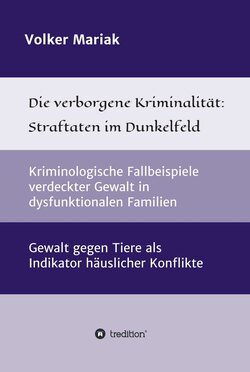Читать книгу Die verborgene Kriminalität: Straftaten im Dunkelfeld - Volker Mariak - Страница 5
На сайте Литреса книга снята с продажи.
Оглавление„Aus forensisch-psychiatrischer Sicht ergeben sich deutliche Hinweise, dass Tierquälereien als frühes Warnsignal für eine spätere deviante Entwicklung gelten müssen, die - wie Einzelfallanalysen gezeigt haben – bis hin zur späteren Mehrfachtötung von Menschen als Umsetzung einer ‚Maximalfantasie’ gehen kann.“
(Heubrock, Dietmar, und Parildayan-Metz, Dorothee: „‚Wer tut denn nur so etwas?’ Zur Kriminalpsychologie des norddeutschen ‚Pferderippers’“, in: Kriminalistik, Heft 1, 2007, Stichwort: Kriminalpsychologie, S. 13)
***
„We must, as prosecutors, recognize that it is unacceptable to excuse and ignore acts of cruelty toward animals. Anyone who can commit such cruelty is in desperate need of incarceration, counseling or other immediate attention. We cannot afford to accept such violence, nor will the public let us.”
(Ritter, A. W., Jr.: „The cycle of violence often begins with violence toward animals.“, in: The Prosecutor, Nr. 30, S. 31 ff., 1996; zitiert nach: Ascione 1998, a. a. O., S. 299)
***
„Determining the forms and prevalence of such cruelty is important since abuse of pets may be a method batterers use to control their partners, may be related to batterers’ lethality, and may result in children in such families being exposed to multiple forms of violence, a significant risk for mental health problems.”
(Ascione, F. R.: „Battered Women’s Reports of Their Partner’s and Their Children’s Cruelty to Animals”, in: Lockwood und Ascione [Hrsg.]: „Cruelty to Animals and Interpersonal Violence. Readings in Research and Application”, Purdue University Press, Indiana, S. 290,1998. Bereits erschienen 1998 in: Journal of Emotional Abuse, Vol. 1, S. 119 ff.)
